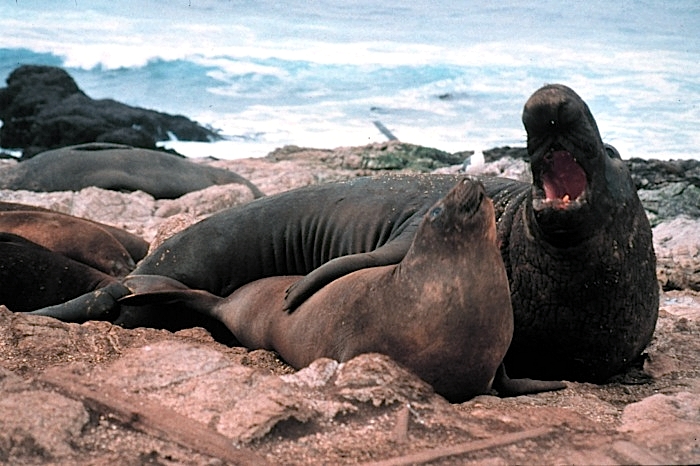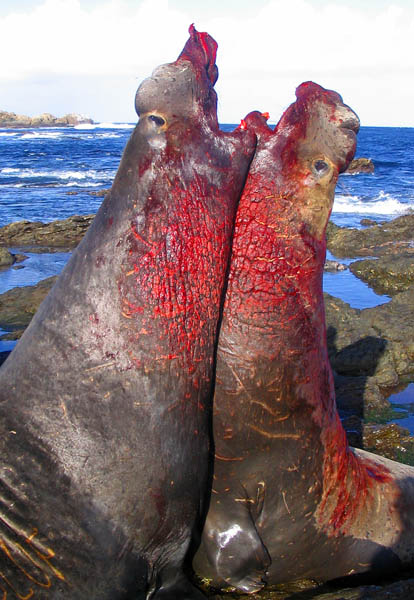 So, while up in San Luis Obispo, I went with my aunt, uncle, and cousin, to one of my favorite places on the central coast: the Piedras Blancas elephant seal colony. So, I figured I'd share some basic information on elephant seals, because they're pretty awesome.
So, while up in San Luis Obispo, I went with my aunt, uncle, and cousin, to one of my favorite places on the central coast: the Piedras Blancas elephant seal colony. So, I figured I'd share some basic information on elephant seals, because they're pretty awesome.First off, there are two species of elephant seals: northern and southern. The southern species is larger, and is in fact larger than all other pinnipeds, and dwells south of the equator, usually in sub-antarctic waters. The northern species (Mirounga angustirostris), while smaller, is no dwarf, especially by seal standards.
 They can reach around 14 feet in length and weigh over 5,000 pounds, at least in the larger males. Elephant seals display what is called sexual dimorphism, wherein the males and females differ anatomically from one another. Elephant seal males are much larger, and they bear an enormous nose, which gives the species it's name. Females are smaller, and lack the large nose, looking more like normal seals. If you look at the above image, a female is pictured on the left, a male on the right.
They can reach around 14 feet in length and weigh over 5,000 pounds, at least in the larger males. Elephant seals display what is called sexual dimorphism, wherein the males and females differ anatomically from one another. Elephant seal males are much larger, and they bear an enormous nose, which gives the species it's name. Females are smaller, and lack the large nose, looking more like normal seals. If you look at the above image, a female is pictured on the left, a male on the right.Elephant seals also have a remarkable yearly behavior cycle. When at sea, they spend a large amount of time underwater, and can dive to incredible depths to hunt squid, often in excess of 1,000 feet below the surface. To aid in this, the seals have specially adapted blood vessels which store carbon dioxide, allowing them to not become poisoned by it, and then expelling it upon surfacing. Their breeding cycle is one of two events that brings them to land. In late fall, males will first hit the beach, and immediately begin to establish territory by fighting with other males over space.
 These fights can be very violent, and males usually have a large amount of scar tissue on their chests from such encounters (I personally saw one when I was around 7 that drew a huge amount of blood, with one male eventually fleeing, bloody, into the surf). Later in the winter, around December, the females then come ashore. It is at this point that the previously established space becomes important, as each female soon settles into a particular area around a male, forming groups of "harems" for each male. The females then give birth, and spend the next few weeks nursing their pup on extremely rich milk, promoting rapid growth. Then comes weaning, in which (sadly) the female will then mate with the nearby male and head out to sea. She may have lost nearly a third of her body weight by this time from nursing, as she does not eat on land at all, and she immediately feeds. The pups are left on the beach to figure it all out, and will eventually enter the ocean themselves, though some linger until spring. The males also depart to feed after mating, and the breeding season ends. They also come back in the summer to molt, which is what I saw this past monday, with the males arriving and shedding first, and the females in late summer.
These fights can be very violent, and males usually have a large amount of scar tissue on their chests from such encounters (I personally saw one when I was around 7 that drew a huge amount of blood, with one male eventually fleeing, bloody, into the surf). Later in the winter, around December, the females then come ashore. It is at this point that the previously established space becomes important, as each female soon settles into a particular area around a male, forming groups of "harems" for each male. The females then give birth, and spend the next few weeks nursing their pup on extremely rich milk, promoting rapid growth. Then comes weaning, in which (sadly) the female will then mate with the nearby male and head out to sea. She may have lost nearly a third of her body weight by this time from nursing, as she does not eat on land at all, and she immediately feeds. The pups are left on the beach to figure it all out, and will eventually enter the ocean themselves, though some linger until spring. The males also depart to feed after mating, and the breeding season ends. They also come back in the summer to molt, which is what I saw this past monday, with the males arriving and shedding first, and the females in late summer.  So, there you have it, these are cool animals, and you should really go check them out if you're ever near Cambria or Hearst Castle.
So, there you have it, these are cool animals, and you should really go check them out if you're ever near Cambria or Hearst Castle.
No comments:
Post a Comment